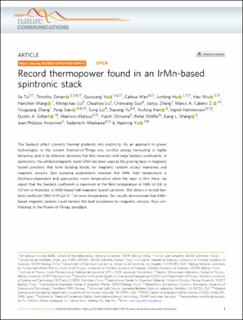| dc.contributor.author | Tu, Sa | |
| dc.contributor.author | Ziman, Timothy | |
| dc.contributor.author | Yu, Guoqiang | |
| dc.contributor.author | Wan, Caihua | |
| dc.contributor.author | Hu, Junfeng | |
| dc.contributor.author | Wu, Hao | |
| dc.contributor.author | Wang, Hanchen | |
| dc.contributor.author | Liu, Mengchao | |
| dc.contributor.author | Liu, Chuanpu | |
| dc.contributor.author | Guo, Chenyang | |
| dc.contributor.author | Zhang, Jianyu | |
| dc.contributor.author | Cabero Z., Marco A. | |
| dc.contributor.author | Zhang, Youguang | |
| dc.contributor.author | Gao, Peng | |
| dc.contributor.author | Liu, Song | |
| dc.contributor.author | Yu, Dapeng | |
| dc.contributor.author | Han, Xiufeng | |
| dc.contributor.author | Hallsteinsen, Ingrid | |
| dc.contributor.author | Gilbert, Dustin A. | |
| dc.contributor.author | Matsuo, Mamoru | |
| dc.contributor.author | Ohnuma, Yuichi | |
| dc.contributor.author | Wölfle, Peter | |
| dc.contributor.author | Wang, Kang L. | |
| dc.contributor.author | Ansermet, Jean-Philippe | |
| dc.contributor.author | Maekawa, Sadamichi | |
| dc.contributor.author | Yu, Haiming | |
| dc.date.accessioned | 2022-05-04T08:05:39Z | |
| dc.date.available | 2022-05-04T08:05:39Z | |
| dc.date.created | 2020-11-06T10:57:01Z | |
| dc.date.issued | 2020 | |
| dc.identifier.citation | Nature Communications. 2020, 11 . | en_US |
| dc.identifier.issn | 2041-1723 | |
| dc.identifier.uri | https://hdl.handle.net/11250/2994052 | |
| dc.description.abstract | The Seebeck effect converts thermal gradients into electricity. As an approach to power technologies in the current Internet-of-Things era, on-chip energy harvesting is highly attractive, and to be effective, demands thin film materials with large Seebeck coefficients. In spintronics, the antiferromagnetic metal IrMn has been used as the pinning layer in magnetic tunnel junctions that form building blocks for magnetic random access memories and magnetic sensors. Spin pumping experiments revealed that IrMn Néel temperature is thickness-dependent and approaches room temperature when the layer is thin. Here, we report that the Seebeck coefficient is maximum at the Néel temperature of IrMn of 0.6 to 4.0 nm in thickness in IrMn-based half magnetic tunnel junctions. We obtain a record Seebeck coefficient 390 (±10) μV K−1 at room temperature. Our results demonstrate that IrMn-based magnetic devices could harvest the heat dissipation for magnetic sensors, thus contributing to the Power-of-Things paradigm. | en_US |
| dc.language.iso | eng | en_US |
| dc.publisher | Nature Research | en_US |
| dc.rights | Navngivelse 4.0 Internasjonal | * |
| dc.rights.uri | http://creativecommons.org/licenses/by/4.0/deed.no | * |
| dc.title | Record thermopower found in an IrMn-based spintronic stack | en_US |
| dc.title.alternative | Record thermopower found in an IrMn-based spintronic stack | en_US |
| dc.type | Peer reviewed | en_US |
| dc.type | Journal article | en_US |
| dc.description.version | publishedVersion | en_US |
| dc.source.pagenumber | 7 | en_US |
| dc.source.volume | 11 | en_US |
| dc.source.journal | Nature Communications | en_US |
| dc.identifier.doi | 10.1038/s41467-020-15797-6 | |
| dc.identifier.cristin | 1845542 | |
| cristin.ispublished | true | |
| cristin.fulltext | original | |
| cristin.qualitycode | 2 | |

